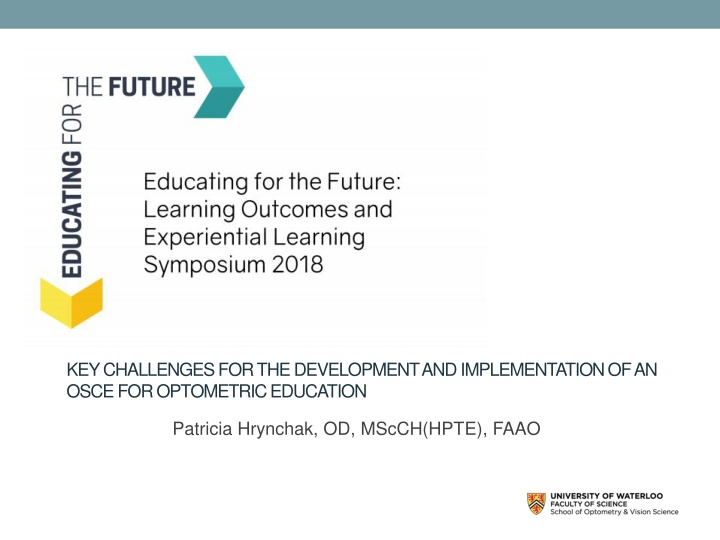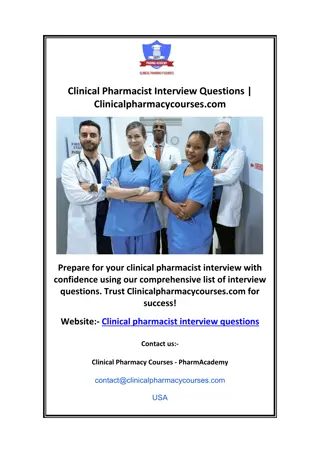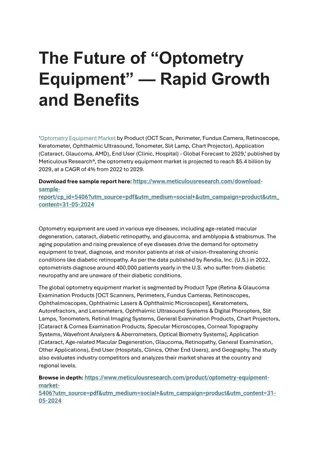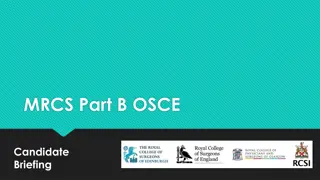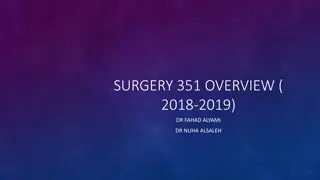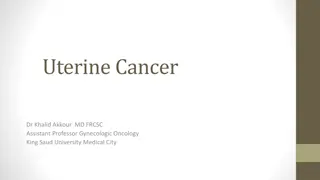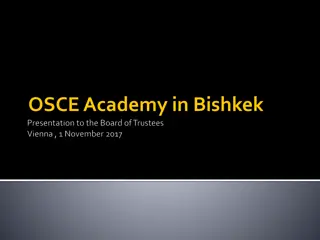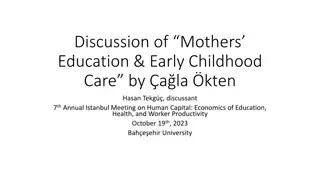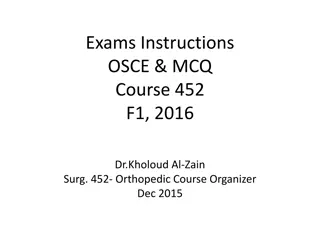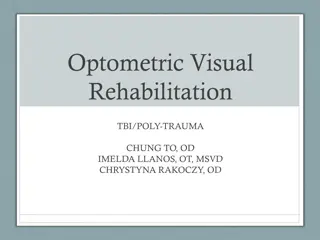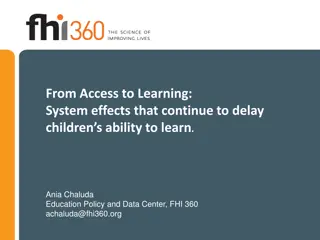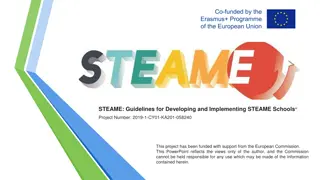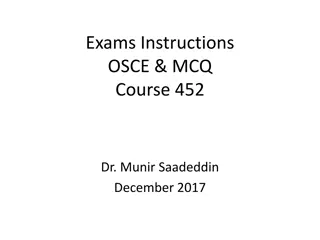Challenges in Developing and Implementing an OSCE for Optometric Education
The presentation by Patricia Hrynchak focuses on the challenges involved in the development and implementation of an Objective Structured Clinical Examination (OSCE) for optometric education. It discusses the need for varied assessment methods, critiques the current use of a global rating scale, and highlights factors affecting the validity and reliability of competence assessments in optometry education.
Download Presentation

Please find below an Image/Link to download the presentation.
The content on the website is provided AS IS for your information and personal use only. It may not be sold, licensed, or shared on other websites without obtaining consent from the author.If you encounter any issues during the download, it is possible that the publisher has removed the file from their server.
You are allowed to download the files provided on this website for personal or commercial use, subject to the condition that they are used lawfully. All files are the property of their respective owners.
The content on the website is provided AS IS for your information and personal use only. It may not be sold, licensed, or shared on other websites without obtaining consent from the author.
E N D
Presentation Transcript
KEY CHALLENGES FOR THE DEVELOPMENT AND IMPLEMENTATION OF AN OSCE FOR OPTOMETRIC EDUCATION Patricia Hrynchak, OD, MScCH(HPTE), FAAO
Disclosures Clinical faculty member at the University of Waterloo, School of Optometry and Vision Science No conflicts of interest
Learning Objectives Define an Objective Structured Clinical Examination Describe the development process for implementing the assessment Appreciate challenges of introducing this form of summative assessment into an existing curriculum 1. 2. 3.
The Assessment of Competence/Outcomes The literature shows that multiple forms of assessment are required to determine if clinical competency has been reached in healthcare education, i.e., a system of assessment Currently, in the University of Waterloo, professional optometry program, only one assessment method is in place, a global rating scale which includes the assessment of 5 clinical skills and 8 clinical behaviors using anchored behavioral descriptors This is used daily during the on-site term and periodically during the external clerkships
The Assessment of Competence/Outcomes Performance ratings determined by use of these global rating scales have the advantages of: rating various aspects of performance evaluating soft traits such as interpersonal skills being less obtrusive than other techniques so the measurement has less effect on the performance providing rapid feedback for formative purposes, and being well known to the clinical instructors
The Assessment of Competence However, the validity and reliability of the tool has also been questioned. Factors affecting the reliability and validity are: limited rater training the relationship between the student and the rater the impact of clinical teaching evaluations completed by the student changing performance expectations by instructors throughout the academic year, and variable patient profiles (e.g., severity of illness).
The Assessment of Competence While this evaluation tool has been found to provide important feedback to the student and facilitate continuous improvement of clinical behaviour it has not been useful in identifying deficient clinical skill performance and therefore, should not stand alone as a reliable measure of clinical competency.
Objective Structured Clinical Examination The OSCE is a performance-based examination in which students are evaluated while demonstrating various clinical skills (e.g., communication including history taking, making a diagnosis, analyzing test results) as they rotate through a series of stations. It is able to assess performance at the shows how level of Miller s pyramid of assessment. The main advantage is that it can assess clinical reasoning in a controlled, objective environment.
Objective Structured Clinical Examination First developed in the 1970s by Ronald Harden, it has been rigorously evaluated with an extensive body of research and has become the international gold standard for evaluating clinical competence. Established in the literature the main challenges to using the OSCE are: The initial faculty development time Increased administrative staff time commitment (e.g., organizing subjects annually) Subject costs
In our context The OSCE will: help prepare students to be successful on national board examinations (as they will gain exposure to this format which is used in the Optometry Examining Board of Canada s entry-to- practice examinations) and, use standardized methodology to increase reliability and validity of the assessment system The results of this assessment will be used in program evaluation to improve the quality of the Doctor of Optometry curriculum.
The Development Process AMEE guide by Khan et al. 2013 The Objective Structured Clinical Examination (OSCE): AMEE Guide No. 81. Part II: organisation & administration. Preparation and Planning Organizational structure Examination scheduling, rules and regulations Blueprinting, mapping and examination length
Blueprinting Content validity is necessary for every assessment and is achieved when the assessment is congruent with the learning objectives and the learning and teaching methods. Learning Objectives Learning Outcomes Learning Outcomes Competencies
Canadian Examining Board of Canada Canadian Journal of Optometry Volume 80 Issue 2
Competency Areas 1. Communication 2. Professionalism 3. Patient Centered Care 4. Assessment 5. Diagnosis & Planning 6. Patient Management 7. Collaborative Practice 8. Scholarship 9. Practice Management Each area has sub-competencies and indicators
Development Process AMEE guide by Khan et al. 2013 The Objective Structured Clinical Examination (OSCE): AMEE Guide No. 81. Part II: organisation & administration. Developing a bank of OSCE stations Choice of topics Choice of station writers Choice of station types Choice of OSCE station writing template Station writing Marking guidance Peer review workshops Piloting (IOBP candidates) Psychometric analysis
Development Process AMEE guide by Khan et al. 2013 The Objective Structured Clinical Examination (OSCE): AMEE Guide No. 81. Part II: organisation & administration. Choosing a scoring rubric and standard stetting Developing a pool of trained examiners (UW School of Optometry) Developing a pool of trained standardized patients (Touchstone Institute or McMaster University)
Standard Setting cut score Criterion vs norm referenced Angoff Method Proportion of borderline candidates that would be able to pass the station prospective Borderline regression Proportion of candidates that were rated as boarderline the mean of their scores is the pass score retrospective
Development Process AMEE guide by Khan et al. 2013 The Objective Structured Clinical Examination (OSCE): AMEE Guide No. 81. Part II: organisation & administration. Running the OSCE Administrative tasks Choosing the venue Setting up the OSCE circuit and equipment Running the OSCE circuit and troubleshooting Post-OSCE considerations Complaints and appeals Quality assurance External examiners Post-hoc psychometrics Evaluation
Challenges First attempt at developing an OSCE was in 2004 It was to replace the existing exit assessment (3 oral examinations) with a more valid and reliable assessment method Work progressed on the project The faculty members of the School of Optometry voted to eliminate exit assessment from the curriculum as they felt that the recently implemented board examination process fulfilled that role
Challenges Renewed interest in using an OSCE as an assessment of competence in 2017 with a change in administration Secure funding in a resource constrained environment Successful Learning Innovation and Teaching Enhancement (LITE) grant at the University of Waterloo $30,000 Money for ongoing administration? Resistance to change Longstanding program (51 years at UW) No competition (only English instruction school in Canada) Traditional curriculum with suspicion of innovation
Challenges Implementation in the curriculum: Proposed as a summative examination for the doctor of optometry program First step was to introduce a milestone into the program that was a requirement to pass But! Faculty support was lacking and the assessment changed to formative from summative Significant concern over the lack of a specific remediation program other than an additional term of clinical training Lack of faculty support blocked change even with Director support
Challenges Scholarship of teaching and learning: Office of research ethics required consent to use data from the examination in any scholarly outputs Ethics consent process onerous Arms length Sealed Students have graduated before consent is known
Challenges Risks to formative assessment Lack of consent Lack of participation The hope is that students will want a change to challenge an examination that is unfamiliar in a no-risk setting to gain the experience
Challenges Time commitment is significant Project team participation has waned Recruitment of assessors Training time for assessors Actual examination time Set up and delivery Staff support
